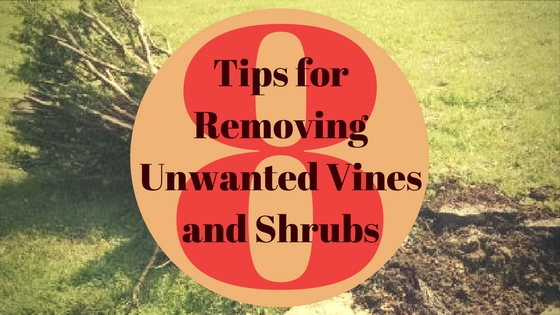8 Tips for Removing Unwanted Vines and Shrubs
Most homeowners reach the place where the decades old landscaping needs a face lift. The vines have covered far more ground than was ever intended. Yews and other shrubs have become difficult to shape and keep attractive. It is time for a change in the outdoor scenery.
Both types of growth can require a considerable amount of work to remove.
Vines look easy enough to remove. One would think that just grabbing them and pulling them out would do the trick. The problem is that just below that nice leafy appearance lurks a fabric of growth that is all but impossible to figure out. Layer after layer of shoots cross the ground and each other.
If you do not mind using plant killer, it might be best to kill the vines first.
Do not try to kill off ivy vines with a simple herbicide. You will need to use the same type of product that is used to kill other woody stemmed plants. Ivy and other vines are very hardy. This is why they survive and destroy all of the other plant life around them. It will take a considerable amount of plant killer to win this battle. You might find it cheaper to just attack them in other ways.
![]() Use good quality work gloves and begin pulling the vines.
Use good quality work gloves and begin pulling the vines.
Removing the vines from the outside toward the middle is the common sense way to start and is usually the most effective. You will be amazed at the pile of plant waste that will accumulate. This will be a very time consuming affair because ivy and other ground covering vines tend to be brittle near where they have rooted along the shoots. Just keep working at this until you have removed most of the vines. If it is dry weather, you might want to water the vines heavily for a few hours before beginning the process.
When the vines are mostly gone, it is time for the heavy equipment.
Because vines like to spring back up from the roots, you will need to go after some of the root systems next. A good quality tiller should be able to complete this task. Take your time and clean the tines frequently. As large quantities of vines and roots are unearthed, you may need to stop and remove these by hand before proceeding. Once it seems that nearly every vine has been removed, you should be able to start converting the space to be used for the next purpose. You may still encounter a vine or two, but if you get them quickly, it should not be a problem.
Shrubs are actually easier to remove than vines most of the time.
Although shrubs like yews and other evergreens are strong plants, they do not spread from roots or shoots like vines. Most shrubs do not have extremely deep or extensive systems of large roots. If the ground is wet down a foot or so, shrubs can usually be pulled out with a chain and a vehicle.
You should be able to remove most shrubs without digging.
With a four wheel drive vehicle, use a long chain and wrap it securely around the base of the shrub as close to the ground as possible. You will want to use a chain with large links. When the chain is secured to the shrub, make sure to hook it on your vehicle in a place that will not break from the strain.
![]() Ease the vehicle forward until the chain is taut.
Ease the vehicle forward until the chain is taut.
This will work best if the vehicle is not sitting in mud. Try to have a place as solid as possible for the vehicle to get traction. With the chain taut, give several quick jerks on the chain. You should see the shrub start to rock and the ground rise around its base.
Learn more about removing old stumps in this post
When the shrub appears to nearly reach a horizontal position during this rocking, it is time to apply some power and try to pull it out. This frequently happens on the first real try after the rocking process. If not, repeat the effort and try again. It rarely takes more than twice to get the job done.
![]() Once all of the shrubs have been removed, you will want to remove the excess roots that remain.
Once all of the shrubs have been removed, you will want to remove the excess roots that remain.
Using a pair of loppers or some type of cutting tool, you can cut away the remaining roots that are near enough to the surface to be in the way. There are normally only a couple of these roots per shrub that have to be addressed. Once these are removed, you should till the area or rake it level before starting the new planting project.



 Use good quality work gloves and begin pulling the vines.
Use good quality work gloves and begin pulling the vines. Ease the vehicle forward until the chain is taut.
Ease the vehicle forward until the chain is taut. Once all of the shrubs have been removed, you will want to remove the excess roots that remain.
Once all of the shrubs have been removed, you will want to remove the excess roots that remain.